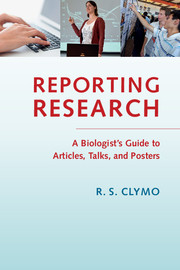4 - Scientific authorship
Published online by Cambridge University Press: 05 October 2014
Summary
How many authors does it take to write an article?
The concept of ‘literary author’ emerged gradually during the eighteenth century, when only a small part of the population was literate, and a print run of 1000 was ‘large’. The concept solidified in the nineteenth century with the introduction of powered printing presses and the spread of the ability to read (Johns 2003). Scientific authorship is different from literary authorship (Biagioli 2003). This chapter is about twenty-first-century writers of articles that describe new scientific work or that review already published scientific work. For brevity I call them author, without qualification. There are no simple rules about authorship, and this chapter is no more than a basis for thought and discussion.
What is an author? The answer is not always obvious. Consider the following patterns.
The science of ecology has passed from simple description to complex experiments, analyses, and modelling in less than a century. The British Ecological Society started the Journal of Ecology in 1913. As Figure 4.1 shows, the journal has grown about fourfold in 90 years, with hiccoughs during the two World Wars. The Society has also initiated five other journals. The growth in the Journal of Ecology is nowadays controlled mainly by finance. (The graphs stop at 2000 because subsequent production changes make comparisons with earlier years too equivocal.)
- Type
- Chapter
- Information
- Reporting ResearchA Biologist's Guide to Articles, Talks, and Posters, pp. 101 - 116Publisher: Cambridge University PressPrint publication year: 2014



